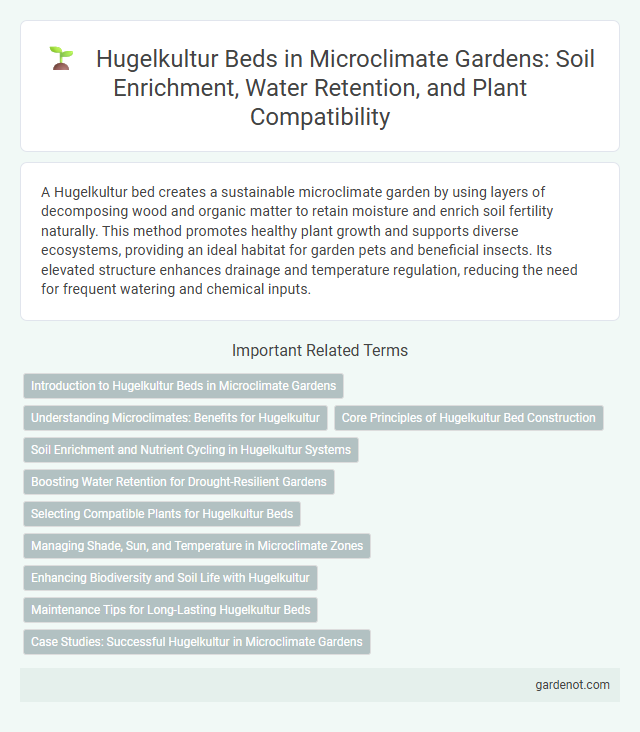A Hugelkultur bed creates a sustainable microclimate garden by using layers of decomposing wood and organic matter to retain moisture and enrich soil fertility naturally. This method promotes healthy plant growth and supports diverse ecosystems, providing an ideal habitat for garden pets and beneficial insects. Its elevated structure enhances drainage and temperature regulation, reducing the need for frequent watering and chemical inputs.
Introduction to Hugelkultur Beds in Microclimate Gardens
Hugelkultur beds are raised garden beds built from decomposing wood and organic materials that improve soil fertility and moisture retention in microclimate gardens. These beds create a self-sustaining ecosystem by slowly releasing nutrients, enhancing microbial activity, and regulating temperature fluctuations in the surrounding environment. Hugelkultur techniques optimize water use efficiency and promote plant resilience in varied microclimate conditions.
Understanding Microclimates: Benefits for Hugelkultur
Hugelkultur beds create diverse microclimates by combining layers of decomposing wood, soil, and organic matter, enhancing moisture retention and temperature regulation. This microclimate variation supports resilient plant growth by improving root aeration and nutrient availability while reducing the need for frequent watering. Understanding these microclimatic benefits allows gardeners to optimize species selection and maximize yield within Hugelkultur systems.
Core Principles of Hugelkultur Bed Construction
Hugelkultur bed construction centers on layering woody debris, such as logs and branches, with compostable organic matter to create a raised garden bed that retains moisture and enriches soil fertility. The core principles include using decomposing wood to act as a sponge, slowly releasing nutrients while improving aeration and microbial activity. This method enhances water retention, reduces the need for irrigation, and fosters a self-sustaining microclimate beneficial for diverse plant growth.
Soil Enrichment and Nutrient Cycling in Hugelkultur Systems
Hugelkultur beds enhance soil enrichment by decomposing wood layers that release essential nutrients over time, improving soil fertility and moisture retention. The nutrient cycling process in these systems supports diverse microbial activity and promotes robust plant growth by continuously replenishing organic matter. This dynamic interaction creates a resilient microclimate garden ecosystem with sustained nutrient availability and improved soil structure.
Boosting Water Retention for Drought-Resilient Gardens
Hugelkultur beds enhance water retention by utilizing decomposing wood and organic material, which absorb and slowly release moisture, creating a self-regulating hydration system. This method significantly reduces watering needs and supports drought-resilient gardens by maintaining consistent soil moisture levels. The increased organic matter also improves soil structure and nutrient availability, promoting healthy plant growth in microclimate garden environments.
Selecting Compatible Plants for Hugelkultur Beds
Selecting compatible plants for Hugelkultur beds involves choosing species that thrive in nutrient-rich, well-drained, and moisture-retentive environments created by decomposing wood layers. Deep-rooted perennials such as comfrey, rhubarb, and asparagus excel in accessing nutrients from the buried organic matter, while shallow-rooted herbs like thyme and oregano benefit from the surface's enhanced moisture retention. Integrating nitrogen-fixing plants like clover or lupines supports soil fertility and promotes balanced nutrient cycling within the Hugelkultur ecosystem.
Managing Shade, Sun, and Temperature in Microclimate Zones
Hugelkultur beds regulate microclimate by managing shade, sun, and temperature through their layered wood and soil structure, which retains moisture and provides insulation. The raised contours create varied microclimate zones, enhancing plant diversity by offering cooler, shaded areas and warmer sun-exposed spots within a small garden footprint. Strategic placement of the bed ensures optimal sunlight exposure and temperature moderation, promoting healthier plant growth and improved ecosystem resilience.
Enhancing Biodiversity and Soil Life with Hugelkultur
Hugelkultur beds significantly enhance biodiversity by creating diverse microhabitats that support a wide range of soil organisms, insects, and plants. The decaying wood core of the bed enriches soil life by providing a sustained source of nutrients, promoting beneficial microbial activity and earthworm populations. This natural decomposition process improves soil structure, moisture retention, and fertility, fostering a thriving micro-ecosystem within the garden.
Maintenance Tips for Long-Lasting Hugelkultur Beds
Hugelkultur beds require minimal maintenance but benefit from regular watering during dry spells to sustain moisture retention. Applying organic mulch and compost annually enhances soil fertility and supports microbial activity crucial for nutrient cycling. Monitoring moisture levels and avoiding soil compaction ensures optimal root growth and prolongs the bed's productivity over time.
Case Studies: Successful Hugelkultur in Microclimate Gardens
Case studies of successful Hugelkultur beds in microclimate gardens reveal significant improvements in soil moisture retention and temperature regulation, enhancing plant growth and resilience. In San Francisco's urban microclimate, a Hugelkultur bed increased biodiversity by 35% and reduced watering needs by 40%, demonstrating its efficiency in water-scarce environments. Research from Germany's temperate zones shows these beds stabilize microclimates by creating warm, nutrient-rich environments, supporting year-round cultivation.
Hugelkultur bed Infographic

 gardenot.com
gardenot.com